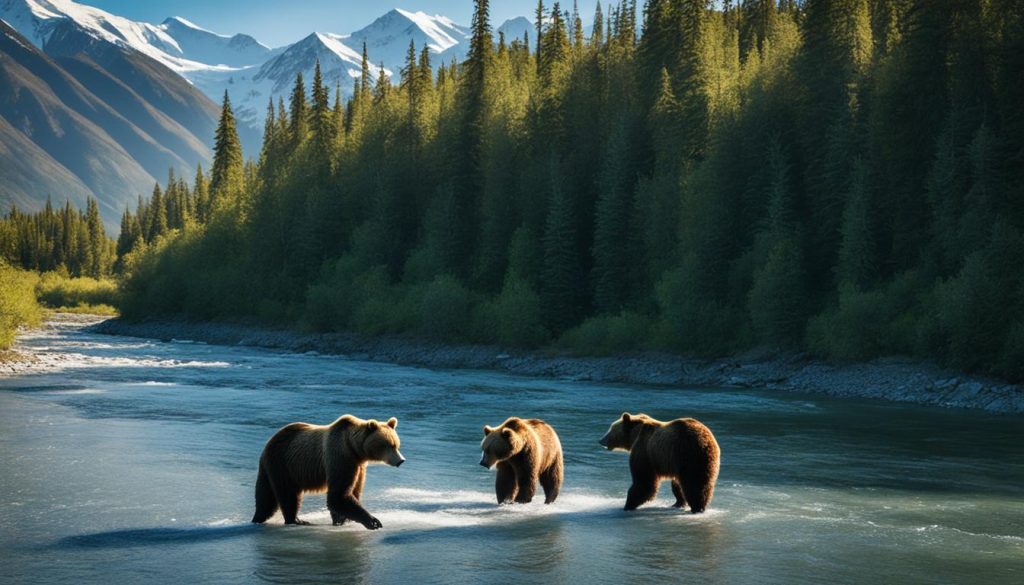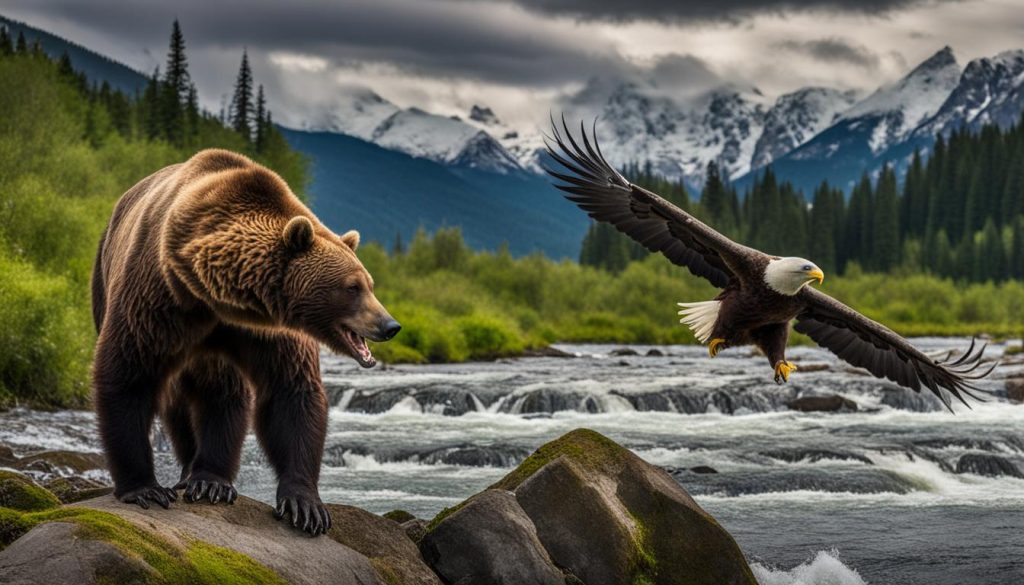Alaska Brown Bear Facts: Things To Know About Bears
Everything You Should Know About Alaskas Brown Bears
When exploring the wilds of Alaska, its hard not to be captivated by the bears that roam its vast landscapes. These majestic creatures not only represent the beauty of Alaska, but are also a large factor in their surrounding ecosystem.
We hope you’ll find these brown bear facts helpful in preparation for your bear adventure tour. Get ready to immerse yourself in the captivating wild world of these bruins!
Key Insights;
Alaska is home to many bears. Adult males can weigh anywhere between 500 and 1,500 pounds, while females typically range from 400 to 900 pounds. One distinguishing feature is their shoulder hump, which aids them in digging.
These incredible creatures inhabit areas throughout Alaska’s wilderness and western Canada including Alaska islands such as Kodiak, Afognak, Admiralty and other islands. They also range the Aleutian Chain and Bering Sea islands. You can also find their presence extending as far as northern parts of Asia and Europe. Chinitna Bay, where we conduct our bear viewing tours, is one of the favorite places to see bears.
Brown bears rely on body language and scent marking as a means of communicating with each other. This behavior becomes especially apparent in areas where multiple bears gather for food – such as Katmai National Park or along the Alaska Peninsula.
Not only do these bears hold a place within their ecosystem, but they also play a vital role in controlling the populations of other species as predators. Additionally their scat helps disperse seeds and promote plant growth—a process, for maintaining an environment.
Interesting Alaska Brown Bear Facts
- Brown bears are scientifically known as Ursus arctos.
- Alaska is home to over 30,000 brown bears, the majority of the U.S. brown bear population.
- Brown bears have a keen sense of smell, enabling them to find food from several miles away.
- Brown bear sizes vary greatly, with weights ranging from 500 to 1,500 pounds.
- Bears of this species possesses high adaptability, making them widespread across various global habitats.
- Brown bears form a pivotal part of numerous conservation efforts in Alaska and worldwide.
Alaska Brown Bears; A Brief Overview
Alaska is home, to some creatures, including the awe inspiring brown bears. These majestic animals have. Thrived in terrains from dense forests to coastal meadows.
Appearance and Size
One of the standout features of bears is their impressive size and robust physique. Adult males can weigh between 400 to 1,500 pounds while female bears are slightly smaller yet still formidable at around 200 to 450 pounds.
Distinguishing these creatures from your black bear are their distinctive shoulder humps, which are a powerful muscle that aids them in digging, and less prominent ears. Additionally their long and straight claws are perfectly suited for expert excavation.
With fur colors ranging from brown to blonde, these impressive bruins command attention wherever they roam. Coastal varieties like the Kodiak bear tend to be even larger than their counterparts due to the abundance of food sources like salmon.
Encountering these beasts in many parts of Alaska, as well as regions in Russia and North America, is an unforgettable experience for adventurers.
As you explore the alpine zones or sub alpine terrains where bears create their winter dens, be sure to stay vigilant for this known alpha of the wild. Keep in mind the importance of bear safety to make sure your experience is a great memory.
To better grasp the scale of size differentials in the brown bear population, let’s consider the following table that indicates common weight ranges in different regions.
| Region | Adult Male Weight | Adult Female Weight |
|---|---|---|
| Alaska | 600 – 1,500 lbs | 500 – 900 lbs |
| Yellowstone | 400 – 600 lbs | 250 – 400 lbs |
| Siberia | 500 – 1,500 lbs | 200 – 800 lbs |
Hibernation Period
One of the most unique Alaska brown bear facts, is that they sleep during the winter months, known as hibernation, which is truly fascinating. These incredible creatures exchange the hunt for salmon and berries for finding cozy dens in secluded areas where they rest without eating, drinking or moving much. During this time their bodies undergo changes as their metabolic rates decrease by half to conserve energy while they rely on their reserves.
Interestingly not all brown bears choose to hibernate when winter arrives. In Alaska some bears skip hibernation due to milder weather conditions that don’t necessitate retreat. Bears with cubs and older bears tend to retire to their dens earlier than solitary males. This period of dormancy enables these magnificent animals to survive the season until natures abundance returns in the spring.
Habitat and Distribution
Brown bears have made their homes in a variety of environments ranging from the regions of the tundra to dense forests and rugged subalpine mountain areas. These remarkable creatures are incredibly adaptable, which allows them to thrive in habitats across Alaska’s vast wilderness and into western Canada and down into the lower 48 where they are known as grizzly bears. They establish territories over a wide range in areas with resources that meet their demanding needs.
These bears have found a home in nearly every part of Alaska with the exception of a few islands and extreme northern areas where polar bears rule the roost. Polar bears and brown bears have been known to share territory and even mate on rare occasions.
Adventurous individuals may come across these animals while they are foraging in natural areas, or catch a glimpse near popular brown bear spots such as Lake Clark National Park, Katmai National Park or along the Alaska Peninsula. Specific places, such as Brooks Falls, often attract them during seasons when they search for salmon.
Communication Methods
Alaska brown bears have an intricate system for interacting with one another without resorting to aggression. Despite having straightforward physical signals and a limited range of vocalizations, these majestic creatures manage to convey complex messages, particularly in areas where food is abundant and many bears gather.
They rely on body posturing, movements, and subtle noises to express their intentions or dominance. This non-verbal language helps maintain order and prevents unnecessary conflicts over resources.
Alaska brown bear behavior also consists of extensive use of scent marking; they rub their bodies against trees to leave behind scents from their glands. Adventurers eager to witness bear communication firsthand should watch for such behaviors during excursions into bear habitats like Katmai National Park and Preserve or along the Alaska Peninsula.
Observing how these intelligent animals interact can be as thrilling as witnessing them catch fish at McNeil Falls or observing cubs play under the vigilant eyes of their mothers.

Alaska’s Brown Bears: A Subspecies with Unique Characteristics
The brown bears of Alaska have distinguished traits reflecting their unique subspecies status. From their size to behaviors, every facet is molded by the demanding wilderness of Alaska. With the ability to hibernate for up to half a year, a diet rich in salmon, and a powerful build, these bears have mastered their environment. As for brown bears ursus arctos, you will not find a more robust predator or survivor anywhere on earth. If you would like to see these amazing bears up close, book a bear viewing tour with us.
The Difference Between Brown Bears and Grizzly Bears
When talking about Alaska brown bear facts, it important to realize that people often confuse brown bears and grizzly bears, but they are two distinct subspecies. While they are related, the term grizzly refers to the North American subspecies of brown bear, named after the grizzled, or gray-tipped, hair. Grizzly bears tend to be smaller than their coastal brown bear counterparts due to a diet less rich in protein. Additionally, grizzlies have a distinct hump of muscle mass on their shoulders, utilitarian embodiments for their frequent digging habits. To learn more about this see our page What’s the Difference Between Grizzly Bears and Brown Bears?
The Difference Between Grizzly and Kodiak Bears
Just as there’s a difference between brown and grizzly bears, there’s a disparity between grizzly and Kodiak bears too. The Kodiak bear is exclusive to the islands of the Kodiak Archipelago in southwestern Alaska. They rank as the largest subspecies of brown bear, and some even consider them to be the largest bears in the world. Their size advantage stems from the abundant and high-quality food supply they have on the islands, particularly the copious salmon runs.

Role in Ecosystem Balance
Alaskas brown bears play a role in maintaining the balance of its ecosystems, acting as caretakers of the land. Their foraging habits not only shape the landscape but also influence the growth of diverse plants and animals. By dispersing seeds and nutrients through their droppings during their journeys these bears contribute to biodiversity.
In the world of these creatures dominance is not about size but also about attitude. The strongest adult males climb to the top of the ladder, which affects how resources are shared within bear communities. Additionally their presence acts as a deterrent for animals from overstaying in one area promoting health across different species.
The behaviors exhibited by bears serve as a check within the food web ensuring population control and vibrant habitats. They maintain populations of species ranging from small rodents to large mammals preventing any one group from dominating the food chain. By regulating herbivores like deer and elk, through predation these powerful bears prevent grazing that could harm vegetation. During salmon runs as they catch and consume fish they help control fish populations by allowing only the strongest individuals to survive and reproduce.
The way this hierarchy works affects how well bears mate and find food, which in turn influences the relationships, between groups of bears in nature. When we talk about reproduction and the life cycle of Alaska bears it becomes evident that these behaviors have an impact on future generations.

Reproduction and Life Cycle
Embark on an adventure into the phases of the Alaska brown bears life from courtship to raising their adorable cubs. Witness the cycle orchestrated by nature ensuring their survival in the Alaskan wilderness.
Discover how these magnificent bears pass on their legacy adapting behaviors and biological processes that showcase the resilience and intricacy of brown bears, Ursus arctos, in their different life stages.
Mating Rituals
As spring flowers blossom and Alaskan landscapes burst with life, brown bears enter a phase of their lives around the age of five when they reach maturity. This is when they go out to find a suitable mate. From May through July male bears wander far and wide following enticing scent trails left by females in heat.
This olfactory matchmaking often leads to captivating courtship rituals. Competing males engage in combat with growls echoing through the forest.
Females display selectiveness while choosing their partners creating a dance that blends aggression with allure. Once they have mated these creatures part ways as the females prepare for motherhood and males continue their journey in search of other mates.
Now lets delve into understanding how gestation and birth unfold after these intricate mating rituals reach their conclusion.
Gestation and Birth
After mating season an extraordinary journey begins for Alaska bears – the journey of new life. The gestation period lasts for months. It includes a fascinating phenomenon called delayed implantation. This allows fertilized eggs to wait before attaching themselves to the uterus until the conditions are suitable for supporting the growth of the fetus.
When winter arrives and the female bear goes into hibernation her body becomes a nurturing sanctuary where cubs are born in the warmth and safety of their den. Usually these cubs come as twins in January or February and are completely vulnerable. They are blind, hairless and weigh less than a pound.
During their weeks of life they rely completely on their mothers milk and warmth to survive against the harsh winter conditions of Alaska. As spring approaches and the ice thaws these tiny creatures will venture out into a world that’s vastly different from what they have known inside their den.
Caring for the Cubs
In the wilderness of Alaska brown bear mothers invest effort into nurturing their young. The cubs depend entirely on their mothers milk for sustenance, which’s crucial for their rapid growth and development during those early years.
The mothers have six nipples providing plenty of opportunities for each cub to feed and thrive. As the cubs grow older under their mothers guidance they start exploring foods, like grasses, roots, herbs and fish.
During the years when the cubs are still dependent, on their parents they form family bonds that can last up to three years. It’s a sight for travelers to witness these family units in action as they demonstrate remarkable parenting skills and survival instincts while exploring Alaskas rugged landscapes.
Predatory Abilities
Possibly one of the most known Alaska brown bear facts, is their predatory skills. What is not always thought about is how those skills are finely tuned by their necessity to secure a variety of food sources throughout seasons. Their substantial size provides them with an advantage when it comes to hunting enabling them to overpower many other species.
These magnificent creatures display an ability to adapt their diet based on availability. During the spawning season they consume large quantities of salmon while also scavenging or driving away smaller predators from their catches. With their incredible sense of smell, brown bears can detect food sources from miles away.
Not only are they strong, but they are surprisingly swift for their size, and capable of reaching speeds that can outpace human sprinters. This unique combination of strength, speed and sensory acuity positions them as top tier predators in Alaskas wilderness.
Moving beyond their role as hunters lets explore how these powerful Alaskan natives significantly contribute to the surrounding ecosystem.

Measures for Protection
Alaskas bears hold importance as symbols of the wild, and their survival relies heavily on effective protection measures. The Alaska Department of Fish and Game leads the way in preserving bear populations through efforts. Strict wildlife management practices are implemented to maintain bear numbers across environments. Biologists consistently monitor bear densities and overall health while adapting conservation strategies as necessary.
Bear safety is increased by regulations concerning food storage practices by campers and hikers. These guidelines aim to reduce the chances of bears getting used to finding food from unnatural sources. The local community and visitors are educated through programs on how to behave when they come across bears in their natural habitats. Knowing what steps to take during encounters can prevent harm to both humans and bears.
Designated protected areas and sanctuaries provide havens for bears and allow them to live without the threats posed by hunting or loss of habitat. Legal restrictions are in place to limit hunting seasons and quotas ensuring a sustainable bear population year after year.
Frequently Asked Questions (FAQ)
How many brown bears are there in Alaska?
There are approximately 30,000 brown bears in The United States. All but about 1,500 are found in Alaska!
How big can Alaskan brown bears get?
A large adult brown bear can get as large as 10 feet tall when standing on their hind legs.
How fast is an Alaskan brown bear?
An average brown bear can reach a speed of 35 miles per hour for short distances. The larger grizzly bear can reach as high as 40 miles per hour for a short sprint.
How long do Alaskan brown bears live?
The average life span of a brown bear is 15 to 25 years. A rescued brown bear in Ukraine, Lady M, lived to be 43 years of age.


